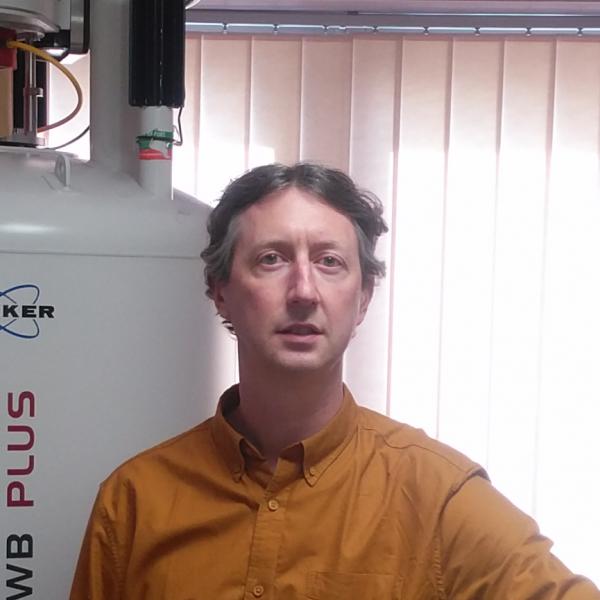Dr Steven Reynolds
School of Medicine and Population Health
Preclinical MRI Facility Manager


+44 114 215 9596
Full contact details
School of Medicine and Population Health
Polaris
18 Claremont Crescent
Sheffield
S10 2TA
- Profile
-
For enquiries please contact - SMPH-West-Operational@sheffield.ac.uk
In 2009, I joined the University of Sheffield as a Senior Research fellow on a CRUK funded programme grant. Here I set up the lab to study cancer metabolism by Hyperpolarised Magnetic Resonance Imaging and Spectroscopy (MRI/S). Previously, I held positions in industry both as part of GE Healthcare (2001-2006), developing scientific instruments, and Oxford Instruments (2006 – 2009), where I led the MRS facility and was responsible for project delivery using the HyperSense hyperpolarisation instrument. It was from these roles that I developed an interest in hyperpolarised magnetic resonance experiments and metabolism.
I have a degree in chemistry from Aston University, where I also received my PhD. I have held research positions at the University of Surrey and the University of Cambridge.
- Research interests
-
My main research interest is in the use of Magnetic Resonance Spectroscopy (MRS) to study cellular metabolism and metabolomics. This is augmented by the use of hyperpolarisation technology that allows in vivo and in vitro cellular metabolism to be studied in real time.
The spermNMR group studies the metabolism of these unique cells to learn more about male factor infertility. Sperm undergo a lot of changes before fertilising an egg. These changes require energy and our research examines how sperm metabolise at different stages of their journey through the female reproductive tract. We use MRS to track the conversion of substrates by different metabolic pathways to understand how sperm produce this energy. Alongside this, I have a longstanding collaboration with Prof Dilly Anumba in studying the metabolic triggers of preterm birth. We examine how the bacteria present in the vagina can influence pregnancy outcomes. These bacteria produce metabolites that can be quantified by MRS and could be used to predict the likelihood of preterm birth.
I also manage the 7T and 9.4T magnetic resonance spectroscopy and imaging facility at the University of Sheffield. Here I have a number of collaborations to develop the use of high resolution MRI, including live zebrafish imaging.
- Publications
-
Show: Featured publications All publications
Featured publications
Journal articles
- Infection/inflammation-associated preterm delivery within 14 days of presentation with symptoms of preterm labour : A multivariate predictive model. PLOS ONE, 14(9). View this article in WRRO


- Probing human sperm metabolism using 13C-magnetic resonance spectroscopy. Molecular Human Reproduction, 25(1), 30-41. View this article in WRRO


- Direct Arterial Injection of Hyperpolarized 13C-Labeled Substrates into Rat Tumors for Rapid MR Detection of Metabolism with Minimal Substrate Dilution. Magnetic Resonance in Medicine. View this article in WRRO


- 1H Magnetic Resonance Spectroscopy of live human sperm.. Molecular Human Reproduction, 23(7), 441-451. View this article in WRRO


- Evidence for rapid oxidative phosphorylation and lactate fermentation in motile human sperm by hyperpolarized 13C magnetic resonance spectroscopy. Scientific Reports, 7(1). View this article in WRRO


- Wireless Accelerometer for Neonatal MRI Motion Artifact Correction. Technologies, 5(1). View this article in WRRO


- Cervicovaginal fluid acetate: a metabolite marker of preterm birth in symptomatic pregnant women. Frontiers in Medicine, 3. View this article in WRRO


- Identifying metabolite markers for preterm birth in cervicovaginal fluid by magnetic resonance spectroscopy. Metabolomics, 12(4). View this article in WRRO


- Measurement of the acute metabolic response to hypoxia in rat tumours in vivo using magnetic resonance spectroscopy and hyperpolarised pyruvate. Radiotherapy and Oncology, 116(3), 392-399.


- NMR-based evaluation of the metabolic profile and response to dichloroacetate of human prostate cancer cells.. NMR Biomed, 27(5), 610-616.


- A system for accurate and automated injection of hyperpolarized substrate with minimal dead time and scalable volumes over a large range.. J Magn Reson, 239(100), 1-8.


- Kinetic modeling of hyperpolarized (13)C pyruvate metabolism in tumors using a measured arterial input function.. Magn Reson Med, 70(4), 943-953.


- Hyperpolarized 13C magnetic resonance detection of carboxypeptidase G2 activity. Magnetic Resonance in Medicine, 62(5), 1300-1304.


- Monitoring the Solid-State Polarization of 13C, 15N, 2H, 29Si and 31P. Applied Magnetic Resonance, 34(3-4), 495-508.


- Therapeutic Target Metabolism Observed Using Hyperpolarized 15N Choline. Journal of the American Chemical Society, 130(14), 4598-4599.


All publications
Journal articles
- Learning rheological parameters of non-Newtonian fluids from velocimetry data. Journal of Fluid Mechanics, 1011. View this article in WRRO


- The pseudokinase TRIB3 controls adipocyte lipid homeostasis and proliferation in vitro and in vivo. Molecular Metabolism, 78. View this article in WRRO


- Longitudinal MRI brain studies in live adult zebrafish. NMR in Biomedicine, 36(7). View this article in WRRO


- Exploring the antimicrobial properties of vaginal Lactobacillus crispatus against preterm birth-associated bacteria. Reproduction and Fertility, 3(3), L6-L8. View this article in WRRO


- NMR spectroscopy of live human asthenozoospermic and normozoospermic sperm metabolism. Reproduction and Fertility, 3(2), 77-89.


- SPG15 protein deficits are at the crossroads between lysosomal abnormalities, altered lipid metabolism and synaptic dysfunction. Human Molecular Genetics, 31(16), 2693-2710. View this article in WRRO


- Kinetic modelling of dissolution dynamic nuclear polarisation 13C magnetic resonance spectroscopy data for analysis of pyruvate delivery and fate in tumours. NMR in Biomedicine, 35(5). View this article in WRRO


- Spectral binning of cervicovaginal fluid metabolites improves prediction of spontaneous preterm birth and Lactobacillus species dominance. Reproduction and Fertility, 2(4), L4-L6.


- Differential vaginalLactobacillusspecies metabolism of glucose, L and D-lactate by13C-nuclear magnetic resonance spectroscopy.


- Infection/inflammation-associated preterm delivery within 14 days of presentation with symptoms of preterm labour : A multivariate predictive model. PLOS ONE, 14(9). View this article in WRRO


- Probing human sperm metabolism using 13C-magnetic resonance spectroscopy. Molecular Human Reproduction, 25(1), 30-41. View this article in WRRO


- Direct Arterial Injection of Hyperpolarized 13C-Labeled Substrates into Rat Tumors for Rapid MR Detection of Metabolism with Minimal Substrate Dilution. Magnetic Resonance in Medicine. View this article in WRRO


- Spontaneous Preterm Birth Is Associated with Differential Expression of Vaginal Metabolites by Lactobacilli-Dominated Microflora. Frontiers in Physiology, 8. View this article in WRRO


- 1H Magnetic Resonance Spectroscopy of live human sperm.. Molecular Human Reproduction, 23(7), 441-451. View this article in WRRO


- Evidence for rapid oxidative phosphorylation and lactate fermentation in motile human sperm by hyperpolarized 13C magnetic resonance spectroscopy. Scientific Reports, 7(1). View this article in WRRO


- Imaging seminiferous tubules – a 9.4T MRI mouse model.


- Wireless Accelerometer for Neonatal MRI Motion Artifact Correction. Technologies, 5(1). View this article in WRRO


- Cervicovaginal fluid acetate: a metabolite marker of preterm birth in symptomatic pregnant women. Frontiers in Medicine, 3. View this article in WRRO


- Identifying metabolite markers for preterm birth in cervicovaginal fluid by magnetic resonance spectroscopy. Metabolomics, 12(4). View this article in WRRO


- Measurement of the acute metabolic response to hypoxia in rat tumours in vivo using magnetic resonance spectroscopy and hyperpolarised pyruvate. Radiotherapy and Oncology, 116(3), 392-399.


- NMR-based evaluation of the metabolic profile and response to dichloroacetate of human prostate cancer cells.. NMR Biomed, 27(5), 610-616.


- A system for accurate and automated injection of hyperpolarized substrate with minimal dead time and scalable volumes over a large range.. J Magn Reson, 239(100), 1-8.


- Kinetic modeling of hyperpolarized (13)C pyruvate metabolism in tumors using a measured arterial input function.. Magn Reson Med, 70(4), 943-953.


- Fully MR-Compatible Syringe Pump for the Controllable Injection of Hyperpolarized Substrate in Animals. Applied Magnetic Resonance, 1-11.


- Hyperpolarized 13C magnetic resonance detection of carboxypeptidase G2 activity. Magnetic Resonance in Medicine, 62(5), 1300-1304.


- Monitoring the Solid-State Polarization of 13C, 15N, 2H, 29Si and 31P. Applied Magnetic Resonance, 34(3-4), 495-508.


- Therapeutic Target Metabolism Observed Using Hyperpolarized 15N Choline. Journal of the American Chemical Society, 130(14), 4598-4599.


- Distinct Modes of Recognition of the Lipoyl Domain as Substrate by the E1 and E3 Components of the Pyruvate Dehydrogenase Multienzyme Complex. Journal of Molecular Biology, 366(1), 132-139.


Book chapters
- Advanced fMRI and the Brain Computer Interface In Hassanien A & Azar A (Ed.), Brain-Computer Interfaces (pp. 185-213).


Conference proceedings
- Metabolic Characteristics of Vaginal Dysbiosis Associated Bacteria: Mobiluncus curtisii and Lactobacillus iners. REPRODUCTIVE SCIENCES, Vol. 30 (pp 192A-192A)


- Metabolic Profiling of Gardenerella vaginalis: A Vaginal Dysbiosis and Preterm Birth-Associated Bacteria.. REPRODUCTIVE SCIENCES, Vol. 28(SUPPL 1) (pp 215A-216A)


- Differential Vaginal Lactobacillus Species Metabolism of Glucose, L- and D-lactate by13C-Nuclear Magnetic Resonance Spectroscopy.. REPRODUCTIVE SCIENCES, Vol. 28(SUPPL 1) (pp 216A-216A)


- Differential Metabolic Profiles of Lactobacillus Species and Preterm Birth-associated Bacteria.. REPRODUCTIVE SCIENCES, Vol. 27(SUPPL 1) (pp 122A-122A)


- Discriminative Capacity of 1H-MRS Spectrum Binning for Preterm Delivery-Associated Lactobacilli-Dominated Vaginal Microbiota.. REPRODUCTIVE SCIENCES, Vol. 26 (pp 212A-212A)


- Decreased cervicovaginal fluid glutamate improves the predictive value of acetate for risk of preterm delivery within two weeks of presentation with threatened preterm labour. BJOG-AN INTERNATIONAL JOURNAL OF OBSTETRICS AND GYNAECOLOGY, Vol. 124 (pp 127-127)


- Prognostic Microbiomial and Metabolite Markers of Preterm Birth in Second Trimester Cervicovaginal Fluid from Women at Risk.. REPRODUCTIVE SCIENCES, Vol. 23 (pp 128A-128A)


- The Association of Cervicovaginal Fluid Metabolites at 20-22 Weeks Gestation with Quantitative Fetal Fibronectin, Ultrasound Cervical Length and Gestational Age at Delivery in Asymptomatic Pregnant Women.. REPRODUCTIVE SCIENCES, Vol. 23 (pp 190A-191A)


- Elucidating Potential Metabolite Markers of Preterm Birth in Cervicovaginal Secretions By Nuclear Magnetic Resonance Spectroscopy. REPRODUCTIVE SCIENCES, Vol. 22 (pp 130A-130A)


Preprints
- Longitudinal brain studies in adult zebrafish by MRI, Cold Spring Harbor Laboratory.


- Infection/inflammation-associated preterm delivery within 14 days of presentation with symptoms of preterm labour : A multivariate predictive model. PLOS ONE, 14(9). View this article in WRRO
- Research group
-
PhD students
- Evie Gruszyk
- Teaching interests
-
I deliver the MRI component of the FRCR (Radiology) programme to the Medical school Undergraduate course. I also contribute to the Student Selected Components on Phase 1b (Research Methods). I supervise Master students on the Reproductive and Developmental medicine course. Outside of the Medical school I provide research experiences for the University’s SURE scheme and Nuffield foundation.
- Professional activities and memberships
-
- Member of the Royal Society of Chemistry.
- Member of the Institute for Physics.
